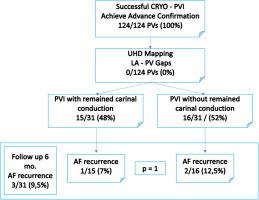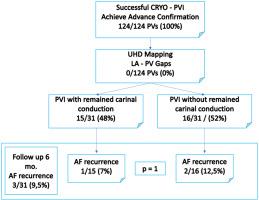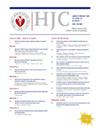利用高分辨率绘图分析最新第四代冷冻气球导管在肺静脉隔离中的有效性
IF 3
3区 医学
Q2 CARDIAC & CARDIOVASCULAR SYSTEMS
引用次数: 0
摘要
长期数据显示,使用冷冻气球消融术重新连接肺静脉的比例高达 27%。这项研究旨在利用超高分辨率绘图评估最新第四代冷冻气球导管的疗效。在心房颤动患者中,使用最新的第四代冷冻气球导管(Arctic Front Advance PRO,美敦力公司,美国明尼阿波利斯)和螺旋绘图导管(Achieve Advance,美敦力公司,美国明尼阿波利斯)进行了标准的肺静脉隔离(PVI)。随后,使用新型多极网格映射导管(Advisor HD Grid SE,美国雅培实验室)实现了高分辨率映射。6 个月后通过 7 天 Holter 心电图进行随访。在我们的研究中,所有 31 名患者都成功实施了急性 PVI。最新的第四代冷冻气球导管在急性 PVI 阶段是安全的。使用多极网格映射导管进行的额外高分辨率映射(每幅映射图的平均点数为 21,001 ± 4911)使我们仅在心肺静脉区域发现了残余间隙,因此没有进行额外的消融。31 例患者中有 3 例(10%)房性心律失常复发总是与肺静脉再连接有关;使用高分辨率绘图在确定将发生再连接的肺静脉方面没有额外的益处。在使用第四代冷冻球囊导管进行 PVI 后,使用 HD Grid 导管进行额外的高密度测绘,与传统的测绘方法(尤其是螺旋测绘导管)相比,并没有明显的优势。在相当一部分患者(48%)中观察到了残余心端传导,这凸显了实现完全电隔离的长期挑战。本文章由计算机程序翻译,如有差异,请以英文原文为准。


Analysis of the effectiveness of the latest 4th-generation cryoballoon catheters in pulmonary vein isolation using high-resolution mapping
Background
Long-term data showed that up to 27% of pulmonary veins are reconnected using cryoballoon ablation. This study aimed to evaluate the efficacy of the latest 4th-generation cryoballoon catheters using ultra high-resolution mapping.
Methods
In patients with atrial fibrillation, a standard pulmonary vein isolation (PVI) with the latest 4th-generation cryoballoon catheter (Arctic Front Advance PRO, Medtronic Minneapolis, USA) and the spiral mapping catheter (Achieve Advance, Medtronic, Minneapolis, MN, USA) was performed. Subsequently, high-resolution mapping was achieved using the novel multipolar grid mapping catheter (Advisor HD Grid SE, Abbott Laboratories, USA). Follow-up was obtained after 6 months by means of a 7-day Holter electrocardiogram.
Results
In our study, acute PVI was successfully achieved in all 31 patients. The latest 4th-generation cryoballoon catheter is safe in the acute phase of PVI. Additional high-resolution mapping (mean points per map 21,001 ± 4911) using the multipolar grid mapping catheter enabled us to identify residual gaps only in the carina pulmonary vein region; therefore, no additional ablation was performed. Three of 31 patients (10%) presented with atrial arrhythmia recurrence always related with pulmonary vein reconnection; using high-resolution mapping had no additional benefit in identifying pulmonary veins in which reconnection will occur.
Conclusion
The utility of additional high-density mapping, facilitated by the HD Grid catheter after PVI with the 4th-generation cryoballoon catheter do not substantiate a discernible advantage over conventional mapping methodologies, particularly, the spiral mapping catheter. Residual carinal conduction was observed in a substantial cohort of patients (48%), highlighting a persistent challenge in achieving complete electrical isolation.
求助全文
通过发布文献求助,成功后即可免费获取论文全文。
去求助
来源期刊

Hellenic Journal of Cardiology
CARDIAC & CARDIOVASCULAR SYSTEMS-
CiteScore
4.90
自引率
7.30%
发文量
86
审稿时长
56 days
期刊介绍:
The Hellenic Journal of Cardiology (International Edition, ISSN 1109-9666) is the official journal of the Hellenic Society of Cardiology and aims to publish high-quality articles on all aspects of cardiovascular medicine. A primary goal is to publish in each issue a number of original articles related to clinical and basic research. Many of these will be accompanied by invited editorial comments.
Hot topics, such as molecular cardiology, and innovative cardiac imaging and electrophysiological mapping techniques, will appear frequently in the journal in the form of invited expert articles or special reports. The Editorial Committee also attaches great importance to subjects related to continuing medical education, the implementation of guidelines and cost effectiveness in cardiology.
 求助内容:
求助内容: 应助结果提醒方式:
应助结果提醒方式:


